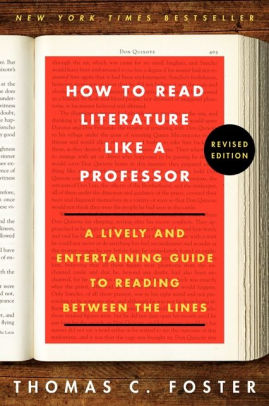
In my graduate school days, of course, I read a great deal of literary criticism and literary theory–some wonderful, some truly awful. But all these many years later, I still find Foster’s book the most useful of all the “how to read literature” books aimed at relatively inexperienced readers (high school and college students).
I reread this one every few years, in fact, because I find it a powerful reminder of ways I can help students gain access to literature beyond their surface readings. This summer, it was required reading for my AP Literature students. Fortunately, even reading it without my guidance, they seem to have taken a great deal from it already. Our discussions this week, both about the Foster book itself, but also about how they applied what they read in Foster to a novel of their choice, have been surprisingly detailed and perceptive. It’s great to see. (It also helps that I’m working with some extraordinarily talented students.)
If you haven’t read Foster yet, it’s worth the time. His style is open, funny, and engaging. He brings in lots of works as examples that you may not have read (yet?), but he always explains the context for those works so you see what he’s doing, whether you’ve read the work or not. And he does all of this in a way that’s memorable, including punchy and funny chapter titles that make it easy to recall his meanings later. (“He’s Blind for a Reason, You Know”)
So if you’re wondering if it’s worth looking at literature “between the lines,” this is a very good guide to making you ask the kinds of questions that will get you there. It’s not stuffy at all, and if you care about literature, you’ll appreciate this book. For those of you more interested in novels than in all genres, he’s also written How to Read Novels Like a Professor, and it’s equally delightful.
I reread this one every few years, in fact, because I find it a powerful reminder of ways I can help students gain access to literature beyond their surface readings. This summer, it was required reading for my AP Literature students. Fortunately, even reading it without my guidance, they seem to have taken a great deal from it already. Our discussions this week, both about the Foster book itself, but also about how they applied what they read in Foster to a novel of their choice, have been surprisingly detailed and perceptive. It’s great to see. (It also helps that I’m working with some extraordinarily talented students.)
If you haven’t read Foster yet, it’s worth the time. His style is open, funny, and engaging. He brings in lots of works as examples that you may not have read (yet?), but he always explains the context for those works so you see what he’s doing, whether you’ve read the work or not. And he does all of this in a way that’s memorable, including punchy and funny chapter titles that make it easy to recall his meanings later. (“He’s Blind for a Reason, You Know”)
So if you’re wondering if it’s worth looking at literature “between the lines,” this is a very good guide to making you ask the kinds of questions that will get you there. It’s not stuffy at all, and if you care about literature, you’ll appreciate this book. For those of you more interested in novels than in all genres, he’s also written How to Read Novels Like a Professor, and it’s equally delightful.
 RSS Feed
RSS Feed
